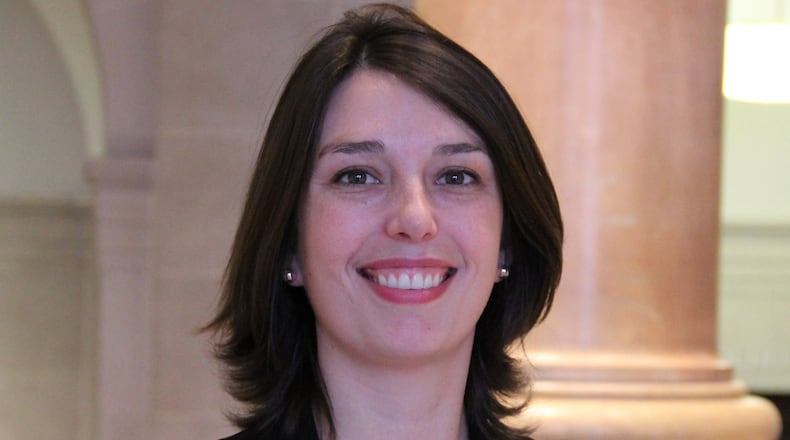A case in point is the current special exhibit, the first Siegwarth has curated since joining the DAI team in 2014. “Ravaged Sublime: Landscape Photography in the 21st Century” completes the museum’s “Year of the Classical Elements” and will be on display through Jan. 8.
The striking exhibition showcases two of Siegwarth’s favorite photographers and presents 30 of their monumental landscapes. “I have long admired both Edward Burtynsky and Richard Mosse, and am thrilled that we have the opportunity to present these internationally recognized artists side-by-side,” she says. “These two artists create stunning photographs within difficult landscapes, and their artworks successfully lure guests within the image to create moments of personal reflection.”
The pictures you’ll see are simultaneously beautiful and disturbing. They demonstrate a variety of ways in which humans have ravaged their environment. “These images demonstrate that photographs as well as landscapes possess a multiplicity of meanings,” says Siegwarth. ” Both are imbued with cultural significance that is ever changing, always evolving, and therefore always relevant.”
In introducing the exhibit at the opening, Siegwarth said these images provide opportunities for engagement with landscapes that many of have either forgotten about or didn’t realize existed. “This for me is particularly true in relation to a photograph depicting an incredible mountain of discarded tires,” she said. “It’s a man-made landscape that I, who recently purchased new tires, am implicated in its creation.”
The artwork — much of it huge — invites visitors to consider their own place within the larger global landscape. “These photographers want you to engage with their work and walk away forming your own opinions,” Siegwarth says.
In conjunction with “Ravaged Sublime,” the DAI is also presenting a small grouping of landscape photographs from its permanent collection, featuring Ansel Adams, Axel Bahnsen and Edward Weston, as well as recent acquisitions by Barry Andersen and Todd Walker.
About the “sublime”
The philosophical concept of the “sublime” dates back to the first-century writings of the Greek philosopher Longinus and refers to the sensation we get when grappling with nature in all of its beauty. The idea reached maturity in the 19th century through the writings of Edmund Burke and Immanuel Kant whose collective works reflect on the sublime as an experience with something so boundless, grand or dangerous that it inspires awe, fear or veneration.
“The sublime is that which startles viewers out of their everyday modes and elicits deep medication, moral reflection and an understanding of our place within this world,” Siegwarth explains. “The exhibition demonstrates that while this is still a profound concept, where we find the sublime has changed as our relationship to the nature and the larger world has dramatically change in the last 200 years.”
The DAI exhibit reflects the contemporary photographer’s interest in challenging both the traditional definition of landscape representation and re-defining what constitutes a sublime experience in the 21st century. In contrast to the 19th century views of places such as Yosemite and Yellowstone National Parks, these photos examine the topographic inversion of open mines, mountains created from discarded tires and aircraft crash sites.
Meet the photographers
Canadian photographer Edward Burtynsky is best known for his depictions of global industrial landscapes. His photographs are included in the collections of over 60 major museums around the world, including the National Gallery of Canada, the Museum of Modern Art, the Guggenheim Museum in New York, the Reina Sofia Museum in Madrid, and the Los Angeles County Museum of Art in California.
Richard Mosse, who will give an artist talk at the DAI on Friday, Dec. 16, was born in Ireland and is based in New York. He is the winner of the 2014 Deutsche Börse Photography Prize and in 2013 represented Ireland in the Venice Biennale with The Enclave, an immersive six-channel video installation that utilized 16mm infrared film.
Among the most striking elements of the exhibit are the vivid hues you’ll see in the photographs by Mosse. His series, entitled “Infra,” shows the ongoing conflict between rebel factions and the Congolese national army in the Democratic Republic of Congo. He uses Kodak Aerochrome, a discontinued, infrared film that was originally developed by the United States military to detect camouflage during aerial reconnaissance. The film registers the spectrum of infrared light invisible to the human eye and shows up as dramatic reds, pinks and lavenders.
Drawing conclusions
Siegwarth explains that while some view these dramatic photos as a call to arms against unsustainable processes — an over-dependency on oil, or for ending human conflicts — others argue that such beautification belies the realities of these situations.
“Photography is inherently ambiguous, allowing photographers to create discussion and dialogue,” she writes. “In the end, it is the visitor’s interpretation of the presented scene — the conclusions they take with them outside the museum galleries— that is crucial.”
Siegwarth says she’s thrilled with the feedback the DAI has been getting on this exhibit and the others in the “classical elements” series. The museum has seen an increase in non-member attendance, including young adults that she’s hoping will grow into future art museum supporters.
The comment book indicates that visitors have been engaged. Wrote one patron: “My three grandchildren think museums are full of old paintings — they saw different today. Now they want to come back.”
Siegwarth says there are a number of ways to engage younger visitors with these dramatic images: “Explain to them that there are different types of landscapes all over the world and ask them to consider the views they see every day — what is similar, what is different and how do these photographs change their idea of what can be a landscape or what is considered beautiful?”
Her own six-year-0ld nephew, she adds, would love the Burtynsky photographs because he’s enamored with construction sites. “Such images provide opportunities to teach children more about the various industrial practices and technological advances that have changed our lives.”
The DAI education team has created an interpretive space to assist younger visitors to engage with the material. Since many younger visitors have used onlu digital cameras or their camera phones, the focus of this area is on the use of film and ‘real’ cameras.
Looking to the future
In addition to developing and coordinating exhibitions, Siegwarth is also responsible for securing and overseeing a balanced variety of traveling exhibitions and working alongside the curatorial team to safeguard the DAI’s collection and to develop new and innovate ways of presenting it to the public. She says joining the museum at this moment is its history, as it nears its centennial, is particularly gratifying. “I believe that The Dayton Art Institute is the true gem of the Gem City.”
Siegwarth values the roles of museums within communities because she believes in their mission and values — to be sites of cultural empathy and inclusion. “Art has the power to provide insights into our past, present, and future,” she concludes. “This exhibition not only demonstrates trends within contemporary photography, but I hope it also presents opportunities for discussion, meditation, and contemplation of the world around us.”
HOW TO GO:
What: “Ravaged Sublime: Landscape Photography in the 21st Century”
Where: Dayton Art Institute, 456 Belmonte Park N. Dayton.
When: Through Jan. 8
Admission: $14 adults; $11 seniors (60+), students (18+ w/ID), active military and groups (10 or more); and $6 youth (ages 7-17). Admission is free for museum members and children, ages 6 and under. Prices include admission to the special exhibition and the museum’s permanent collection.
ARTIST TALK: An artist talk with photographer Richard Mosse is slated for 6:30 p.m. on Friday, Dec. 16. Tickets are $5 for museum members and $10 for non-members. A $20 combination ticket for non-members includes admission to the special exhibition.
Docent-led tours of "Ravaged Sublime" are available for individuals, groups and schools. Contact Donna Young at (937) 512-0152 or dyoung@daytonart.org. For K-12 school tours, contact Rique Hagen, at (937) 223-4278, ext. 332 or schooltours@daytonart.org.
Other upcoming events: A Ravaged Sublime Tour and Terrarium Workshop will be held from 1-3 p.m. Saturday, December 3. Curatorial Conversations: Ravaged Sublime Tour will take place from 6-7 p.m. on Thursday, December 8.
For more information: visit daytonartinstitute.org/ravagedsublime. Look for the hashtag #RavagedSublime on social media.
About the Author


